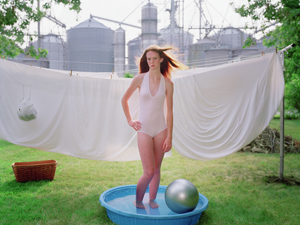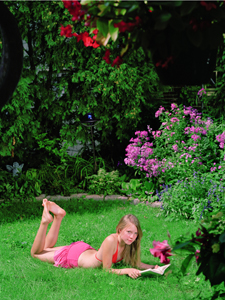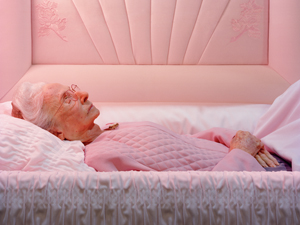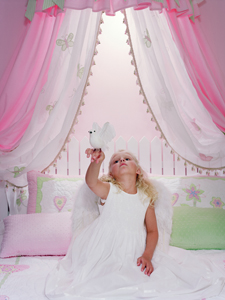Submission & Rebellion: Details in the Photographs of Angela Strassheim
Callie Clark-Wiren reviews "Angela Strassheim Photographs" at Chambers Burnet Art Gallery





In the photograph Alicia in the Pool (2006), Alicia is in a rural setting. She seems only slightly uncomfortable in front of the camera. It seems simply a portrait of a girl, but when you look more closely, you see she’s wearing a thin one-piece white swimming suit and her hairless genitalia are clearly visible. Amy Reading a Book, also from 2006, is a portrait of a teenage girl in a tranquil environment; however, Amy isn’t accidentally seductive as Alicia may be. She’s scantily clad and gazes seductively at the viewer.
Angela Strassheim is currently exhibiting these photographs and more at Ralph Burnet’s gallery at Chambers Hotel in downtown Minneapolis. The Chambers-Burnet Gallery is claiming its place in the cultural landscape of Minneapolis: high art adorns the public and private spaces of the hotel as well as the gallery. The main collection consists of works by Young British Artists, as well as trendy Asian and Indian artists such as Subodh Gupta and Morimura and Ahn Sung-ha. Other fashionable international artists are represented as well. The current exhibition shows an artist from the 2006 Whitney Biennial, which was co-curated by Philippe Vergne, senior curator at the Walker Art Center.The 2006 Biennial, which was titled “Day for Night,” examined the darker side of American consciousness.
The photographs in this exhibition are a mixture of images from Strassheim’s two most recent collections: “Left Behind” and “Pause.” These photographs are autobiographical portraits, or images of her family that create tableaus of the culture in which she grew up, and that illustrate the conflicting undertones circulating within the family’s way of life. Strassheim explores the strict born-again Christian communities of rural Iowa and suburban Minnesota that she called home, and exposes unsettling stories. She creates tranquil scenes but then includes details that can make the viewer uncomfortable and cause questions about the image to arise. This process of attention to detail in the entire frame of the image comes from her experience as a forensic photographer in Miami, where she would photograph up to ten bodies a day.
Spanking (2006) and Father and Son (2004) illustrate the domination of the father in the family. In Spanking a father spanks the bare bottom of a daughter who is old enough, and sufficiently aware of her own seductiveness, to be wearing underwear from Victoria’s Secret. The son’s eyes in Father and Son have a look of resignation and a broken spirit. Storytelling (2005), Prayer (2005), and Makayla (2006) all contain a series of looks, either at the camera or among the family members, that illustrate these power structures, and hint at either submission to or rebellion against them.
In these works Strassheim depicts abuses of power in the family, in particular paternal power, but also hints at other kinds of power: that of young girls’ sexuality, that of submission and rebellion, inclusion and isolation, and the vigor of those who face the rawer kinds of power. She has referred to these tableaux as autobiographical, leading one to speculate about the life of the photographer who sets up these images.
One is not sure how far to push her statement; the viewer also becomes complicit in these family dramas, taking sides, depending on one’s own family, history, gender, and roles. The ambiguous and uncomfortable nature of her photographs brings up issues of hypocrisy: which certainly can be found in zealous religious environments, as well as in more normally constituted family life—if that even exists. Another thread that the work can inspire is thinking about how religious or moral extremism can press young people to one of two paths: resigned obedience or acute rebellion.
These works lead viewers to think about power flows within families, and also about extremism in religion, not just in the realm of Muslim terrorists, but in our own backyards and living rooms. Extremist Christians may not be destroying landmarks, but there are many kinds of destruction, some of them far more intimate. Strassheim encourages us to look beyond the surfaces of ordinary families, our own or others. She inspires meditation on the roles of family members in each other’s lives, and even can cause an uneasy sensitivity to signs of family tyranny around us—something we often choose to ignore.